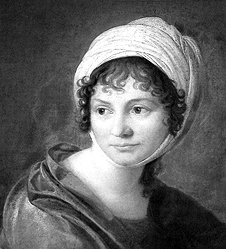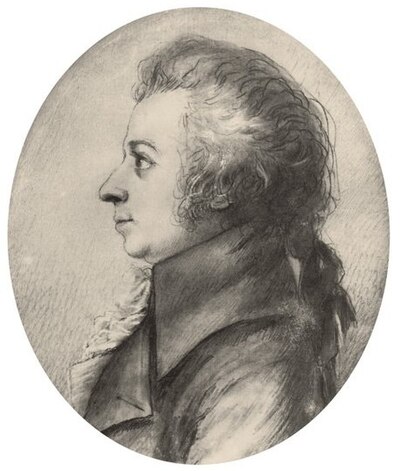| Revision as of 01:19, 12 December 2007 editOpus33 (talk | contribs)Autopatrolled, Extended confirmed users, Pending changes reviewers, Rollbackers17,045 edits History of the portrait← Previous edit | Revision as of 02:51, 12 December 2007 edit undoOpus33 (talk | contribs)Autopatrolled, Extended confirmed users, Pending changes reviewers, Rollbackers17,045 edits an assessment; more bioNext edit → | ||
| Line 1: | Line 1: | ||
| ]]] | ]]] | ||
| '''Doris (Dora, Dorothea) Stock''' (1760- |
'''Doris (Dora, Dorothea) Stock''' (1760-1832) was an amateur artist of the 18th and 19th centuries. She is best remembered for making one of the last portraits of ], as well as for telling a characteristic anecdote about him. | ||
| She was born to a Leipzig copper engraver. In her youth, she met the 16-year-old ], who had come to study with her father; he became a "lifelong friend".<ref>Anonymous (1999)</ref> | |||
| She was a member of the Dresden Academy of Art; her work was exhibited there five times during the years 1800-1813.<ref>Anonymous (1999)</ref> | |||
| ==Stock's Mozart portrait== | ==Stock's Mozart portrait== | ||
| At this time, Mozart was passing through town and giving concerts, as part of the ] he made during Spring 1789. On either 16 or 17 April, 1789, Mozart made a social visit to the Körner home. Stock, a capable draftsman, took the occasion to sketch a portrait of Mozart in ] on ]: | In April 1789, when she produced her Mozart portrait, she was unmarried and living in the Dresden home of her sister, Anna Maria Jakobine (Minna), the wife of the consistorial councillor ].<ref>Burmeister 2006</ref> At this time, Mozart was passing through town and giving concerts, as part of the ] he made during Spring 1789. On either 16 or 17 April, 1789, Mozart made a social visit to the Körner home. Stock, a capable draftsman, took the occasion to sketch a portrait of Mozart in ] on ]: | ||
| ] | ] | ||
| Line 16: | Line 18: | ||
| Albi Rosenthal, the picture's one-time owner, indicates that the portrait was kept by Friedrich Körner (whom he does not identify) for some 50 years after it was made.<ref>Rosenthal 1995</ref> Its further history was given by the German newspaper ''Die Welt'': "the picture passed from the Körners to the ] ]; later it was possessed by ], the owner of the ] music publishers of ]. He was murdered in ] in 1942. His heirs gave the picture to the Rosenthal family in thanks for their help."<ref>Issue of 4 November, 2005; downloaded from http://www.welt.de/print-welt/article175400/Wirklich_echter_Amadeus.html 10 December 2007. German original: "Die Zeichnung ging von den Körners an den Dirigenten Carl Eckert, dann besaß sie Henri Hinrichsen, der Eigentümer des Leipziger C. F. Peters Musikverlags. Er wurde 1942 in Auschwitz ermordet. Seine Erben schenkten es als Dank für ihre Hilfe der Familie Rosenthal."</ref> | Albi Rosenthal, the picture's one-time owner, indicates that the portrait was kept by Friedrich Körner (whom he does not identify) for some 50 years after it was made.<ref>Rosenthal 1995</ref> Its further history was given by the German newspaper ''Die Welt'': "the picture passed from the Körners to the ] ]; later it was possessed by ], the owner of the ] music publishers of ]. He was murdered in ] in 1942. His heirs gave the picture to the Rosenthal family in thanks for their help."<ref>Issue of 4 November, 2005; downloaded from http://www.welt.de/print-welt/article175400/Wirklich_echter_Amadeus.html 10 December 2007. German original: "Die Zeichnung ging von den Körners an den Dirigenten Carl Eckert, dann besaß sie Henri Hinrichsen, der Eigentümer des Leipziger C. F. Peters Musikverlags. Er wurde 1942 in Auschwitz ermordet. Seine Erben schenkten es als Dank für ihre Hilfe der Familie Rosenthal."</ref> | ||
| At the end of 2005, the Rosenthal family sold the picture to the ] in ] for about |
At the end of 2005, the Rosenthal family sold the picture to the ] in ] for about 250,000 British pounds. Being very fragile, it is kept in the museum's protective vaults; only a replica is on display.<ref>Issue of 4 November, 2005; downloaded from http://www.welt.de/print-welt/article175400/Wirklich_echter_Amadeus.html 10 December 2007.</ref> | ||
| ==Stock's Mozart anecdote== | ==Stock's Mozart anecdote== | ||
| Line 25: | Line 27: | ||
| Deutsch (reference below) notes that the anecdote probably exaggerates the number of times that Mozart visited the Körner home. The house was on the street in Dresden now called the Körnergasse. | Deutsch (reference below) notes that the anecdote probably exaggerates the number of times that Mozart visited the Körner home. The house was on the street in Dresden now called the Körnergasse. | ||
| ==Assessment== | |||
| An anonymous reviewer says of Stock that she "recoiled from vanity or exaggeration, values that are evident in her extremely competent and brutally honest portraits."<ref>Anonymous (1999)</ref> | |||
| ==Notes== | ==Notes== | ||
| Line 40: | Line 46: | ||
| Other references consulted: | Other references consulted: | ||
| *Anonymous (1999) Review of ''Dora Stock, portrait painter of the Körner circle in Vienna''. ''Woman's Art Journal'', Vol. 20, No. 1. (Spring - Summer), p. 67. Available on ]. | |||
| *Burmeister, Klaus (2006) "Besuch aus Wien: Mozart in Dresden während seiner Reise über Prag und Leipzig nach Berlin," ''Philharmonische Blätter'', Dresdner Philharmonie, January-March issue. In German. | *Burmeister, Klaus (2006) "Besuch aus Wien: Mozart in Dresden während seiner Reise über Prag und Leipzig nach Berlin," ''Philharmonische Blätter'', Dresdner Philharmonie, January-March issue. In German. | ||
| *Rosenthal, Albi (1995) "Laughing Stock," letter to the editor, ''The Musical Times'', Vol. 136, No. 1833, (November), p. 572. Available on ]. | *Rosenthal, Albi (1995) "Laughing Stock," letter to the editor, ''The Musical Times'', Vol. 136, No. 1833, (November), p. 572. Available on ]. | ||
Revision as of 02:51, 12 December 2007

Doris (Dora, Dorothea) Stock (1760-1832) was an amateur artist of the 18th and 19th centuries. She is best remembered for making one of the last portraits of Wolfgang Amadeus Mozart, as well as for telling a characteristic anecdote about him.
She was born to a Leipzig copper engraver. In her youth, she met the 16-year-old Johann Wolfgang von Goethe, who had come to study with her father; he became a "lifelong friend".
She was a member of the Dresden Academy of Art; her work was exhibited there five times during the years 1800-1813.
Stock's Mozart portrait
In April 1789, when she produced her Mozart portrait, she was unmarried and living in the Dresden home of her sister, Anna Maria Jakobine (Minna), the wife of the consistorial councillor Christian Gottfried Körner. At this time, Mozart was passing through town and giving concerts, as part of the Berlin journey he made during Spring 1789. On either 16 or 17 April, 1789, Mozart made a social visit to the Körner home. Stock, a capable draftsman, took the occasion to sketch a portrait of Mozart in silverpoint on ivory board:

Apparently silverpoint was not widely practiced at the time (see silverpoint); Stock may have known the medium from having been the daughter of an engraver.
History of the portrait
Albi Rosenthal, the picture's one-time owner, indicates that the portrait was kept by Friedrich Körner (whom he does not identify) for some 50 years after it was made. Its further history was given by the German newspaper Die Welt: "the picture passed from the Körners to the conductor Carl Eckert; later it was possessed by Henri Hinrichsen, the owner of the C. F. Peters music publishers of Leipzig. He was murdered in Auschwitz in 1942. His heirs gave the picture to the Rosenthal family in thanks for their help."
At the end of 2005, the Rosenthal family sold the picture to the Mozarteum in Salzburg for about 250,000 British pounds. Being very fragile, it is kept in the museum's protective vaults; only a replica is on display.
Stock's Mozart anecdote
Nineteen years after her death, Gustav Parthey published a book called Jugenderinnerungen ("Remembrances of youth", 1871). He related a tale about Mozart's visit that Doris Stock had told him during her lifetime:
- Mozart himself, during his short stay in Dresden, was an almost daily visitor to the Körners' house. For the charming and witty Doris he was all aflame and with his south Germanvivacity he paid her the naïvest compliments. He generally came shortly before dinner and, after he had poured out a stream of gallant phrases, he sat down to improvise at the pianoforte. In the next room the table was meanwhile being set and the soup dished up, and the servant announced that dinner was served. But who could tear himself away when Mozart was improvising! The soup was allowed to grow cold and the roast to burn, simply so that we could continue to listen to the magic sound which the master, completely absorbed in what he was doing and unaware of the rest of the world, conjured from the instrument. Yet one finally grows tired even of the highest pleasures when the stomach makes known its demands. After the soup had grown cold a few times while Mozart played, he was briefly taken to task. "Mozart", said Doris, gently laying her snow-white arm on his shoulder, "Mozart, we are going in to dine; do you want to eat with us?" But it was precisely Mozart who never did come; he played on undisturbed. Thus we often had the rarest Mozartian musical accompaniment to our meal, Doris concluded her narrative, and when we rose from table we found him still sitting at the keyboard.
Deutsch (reference below) notes that the anecdote probably exaggerates the number of times that Mozart visited the Körner home. The house was on the street in Dresden now called the Körnergasse.
Assessment
An anonymous reviewer says of Stock that she "recoiled from vanity or exaggeration, values that are evident in her extremely competent and brutally honest portraits."
Notes
- Anonymous (1999)
- Anonymous (1999)
- Burmeister 2006
- Rosenthal 1995
- Issue of 4 November, 2005; downloaded from http://www.welt.de/print-welt/article175400/Wirklich_echter_Amadeus.html 10 December 2007. German original: "Die Zeichnung ging von den Körners an den Dirigenten Carl Eckert, dann besaß sie Henri Hinrichsen, der Eigentümer des Leipziger C. F. Peters Musikverlags. Er wurde 1942 in Auschwitz ermordet. Seine Erben schenkten es als Dank für ihre Hilfe der Familie Rosenthal."
- Issue of 4 November, 2005; downloaded from http://www.welt.de/print-welt/article175400/Wirklich_echter_Amadeus.html 10 December 2007.
- Mozart was from Salzburg, now part of Austria. At the time Salzburg was a quasi-independent country, one of the hundreds of small states collectively referred to at the time as "Germany".
- From Deutsch (1965, 568-569). The German original can be found in Burmeister.
- Anonymous (1999)
References
Except as indicate by footnote all information in this article is taken from the following reference source:
- Deutsch, Otto Erich (1965) Mozart: A Documentary Biography. Stanford, CA: Stanford University Press.
The discussion of Stock's portrait appears on p. 340, the dinner anecdote on pp. 568-569.
Other references consulted:
- Anonymous (1999) Review of Dora Stock, portrait painter of the Körner circle in Vienna. Woman's Art Journal, Vol. 20, No. 1. (Spring - Summer), p. 67. Available on JSTOR.
- Burmeister, Klaus (2006) "Besuch aus Wien: Mozart in Dresden während seiner Reise über Prag und Leipzig nach Berlin," Philharmonische Blätter, Dresdner Philharmonie, January-March issue. In German.
- Rosenthal, Albi (1995) "Laughing Stock," letter to the editor, The Musical Times, Vol. 136, No. 1833, (November), p. 572. Available on JSTOR.